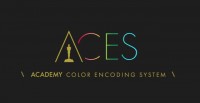ACES: New Features, Governance, Timeline, Call to Action
April 11, 2019
In a packed NAB 2019 Birds of a Feather session, ACES (Academy Color Encoding System) project chair Annie Chang led a meeting to bring attendees up to date on the volunteer group’s latest work. “ACES is a beast,” said Chang, urging attendees to share their feedback and get involved in the various committees. “We need to understand what people need to get it working.” She also mentioned that with SMPTE’s standardized ACES IMF format as an archival format, IMF and ACES are working together.
Chair of the CLF (Common LUT Format) working group JD Vandenberg reported on the work his group has done to help refine the specifications for the CLF: “We have several goals. One is to be a universal file format for LUTs and also be a format that can include several transforms, to be serialized in one file.” He stressed that CLF is not a part of ACES, but instead can be used with or without ACES. “It is also not a hardware-optimized LUT format or a multi-branch color corrector transport format for saving a color grading session,” he said.

The working group has divided its efforts into three steps: spec review, code review and implementation review. “We’re in the first step now, and looking into XML formatting, integer support, and what’s required vs. optional,” Vandenberg noted. “Currently under consideration are a list of pre-defined transfer functions, full invertibility, adding nodes to specs and adding parametric functions.”
Chris Clark, who chairs the ACESclip working group, noted that metadata was part of the ACES system defined in 2014, but didn’t see much adoption. “Our goal was to go back to the drawing board and see the real requirements of this spec,” he said. “Our goal is to find what’s critical. We want this to be an open standard that metadata can be carried in.”
He added, the group is looking into “software/hardware responsible for creating, modifying and reading ACESclip metadata.” The team also checked the spec at its basic requirements in order to resolve production issues, as they must “define the real requirements and the use cases based on those requirements.”
Among the “must haves” are the ACES viewing recipe, ability to work with non-ACES working spaces/images such as camera log formats, and custom transforms (CLF). “It would be nice to have the history of viewing recipes and multiple recipes,” he said. “But what about framing information? Where do we stop?” In the audience, ASC cinematographer Bill Bennett made the case that including framing information is crucial.
ACES vice chair Joachim “JZ” Zell reported the IDT working group is upcoming, and encouraged attendees to stay tuned on the ACES Central website. Chang announced that, with regard to governance, the group has “a process and structure for ACESnext, based on ASWF/Linux [open source] foundation principles.” ACES has formed two Technical Advisory Committees (TACs) to provide advice and help with governance, and ACES 1.2 has been tapped as the proof of concept version, targeted for a fall 2019 release.
“New features will be the new CLF specification, new ACESclip specification with versioning support; and non-ACES grading and custom LMT application space support via ACESclip,” she said.
Features under discussion are simplified RRT, parametric output transform, parametric dim surround support, production-ready reference implementation (including interchangeable programmatic LMT format and interchangeable IDT format), and improved end-user documentation as well as a “major fix” on gamut management to deal with the purple fringe problem. The release of ACES 2.0 is due sometime in 2020.
“There are a lot of issues we want to resolve,” said Chang, “but we can’t do it without community.”

No Comments Yet
You can be the first to comment!
Sorry, comments for this entry are closed at this time.